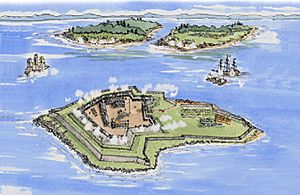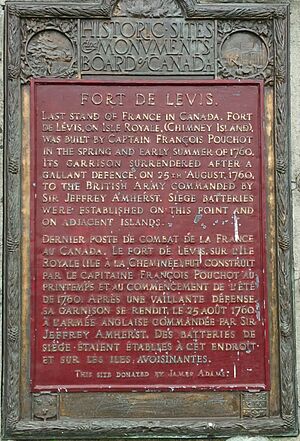Fort Lévis facts for kids
Quick facts for kids Fort Lévis |
|
|---|---|
| Ogdensburg, New York | |

Map of Fort Lévis
|
|
| Type | Fort |
| Site information | |
| Controlled by | New France |
| Site history | |
| Built | 1759 |
| In use | 1759–1760 |
| Battles/wars | |
|
Fort Lévis
|
|
| Location | Isle Royale, near Ogdensburg, New York |
| Area | 23.75 acres (9.61 ha) |
| NRHP reference No. | 10000944 |
| Added to NRHP | 26 November 2010 |
Fort Lévis was a strong fort built by the French in 1759. It was located on the St. Lawrence River. The French built it to protect their lands from the British. They named it after François Gaston de Lévis, Duc de Lévis, a French commander. The fort was on an island called Isle Royale, about 3 miles from another fort.
In August 1760, the British attacked Fort Lévis. The French soldiers had to surrender after a big fight. The British then renamed the fort Fort William Augustus. The fort was left empty in 1766. Later, when the Saint Lawrence Seaway was built, the old fort was covered by water.
Why Fort Lévis Was Built
The French started settling along the St. Lawrence River. They also created important trade routes deep into the continent. To keep these areas safe, they built forts along rivers and lakes.
One fort, Fort de La Présentation, was already on the St. Lawrence River. There was also a shipyard nearby. But the French leaders felt these defenses were not strong enough. So, in September 1759, they ordered a new fort built. This new fort, Fort Lévis, was placed on Isle Royale.
The fort was built to stop the British during the French and Indian War. It was meant to protect French settlers and Iroquois people. The island was a good choice because it had steep cliffs. Also, there were rapids nearby. This meant enemy ships would have to sail slowly, one at a time.
What Fort Lévis Looked Like
The original plan for Fort Lévis was very grand. François Gaston de Lévis, Duc de Lévis wanted a stone fort with 200 guns. He also wanted a large army of 2,500 soldiers. But there wasn't enough time to build such a big fort.
So, Fort Lévis ended up being a large fort made of earth and wood. Its walls were one log thick. Inside, there were casemates, which are protected rooms. Some were covered, and some were open. There were also four barracks for soldiers. A shop for armorers and blacksmiths was in the center.
The island had a small harbor for boats. The main part of the fort faced west. It had special corner parts called demi-bastions facing east.
The fort never got all 200 guns. By the time of the Battle of the Thousand Islands, it had fewer. Some iron cannons had their trunions (parts that help them turn) removed. This made them hard to move. The fort also had twelve 12-pounder guns, two 8-pounder guns, thirteen 4-pounder guns, and four 1-pounder guns. There were also four brass 6-pounder guns.
Key Events and Battles
Building Fort Lévis started in September 1759. In 1760, during the Seven Years' War, Major-General Amherst led his army. He was marching to capture Montreal. The Duc de Lévis, who was in charge of French forces, gave an order. He told Captain Pierre Pouchot to slow down Amherst's army.
Captain Pouchot was from the Régiment de Béarn. He decided to move soldiers from nearby forts. He evacuated Fort de La Présentation and Pointe aux Baril. These forts were too easy for Amherst's guns to hit. Pouchot set up his defense at Fort Lévis. He had 340 regular soldiers from the Compagnies Franches de la Marine. He also had Canadian militiamen.
On August 20, 1760, Amherst's ships began to attack the island. British soldiers also placed guns on nearby shores and islands. This allowed them to shoot at the fort from different directions. By August 24, Pouchot's soldiers ran out of ammunition. He had to surrender to Amherst.
Amherst then renamed the fort Fort William Augustus. This was after Prince William, Duke of Cumberland, who led the British Army. Amherst then left to capture Montreal. The British soldiers who stayed behind began to rebuild the fort. However, the British left the fort in 1766.
The island where the fort stood is called Chimney Island or Isle Royale. Part of it was destroyed in the 1950s. This happened when the Saint Lawrence Seaway was being built. Today, the remains of the fort are under the water. They are near Ogdensburg, New York.



